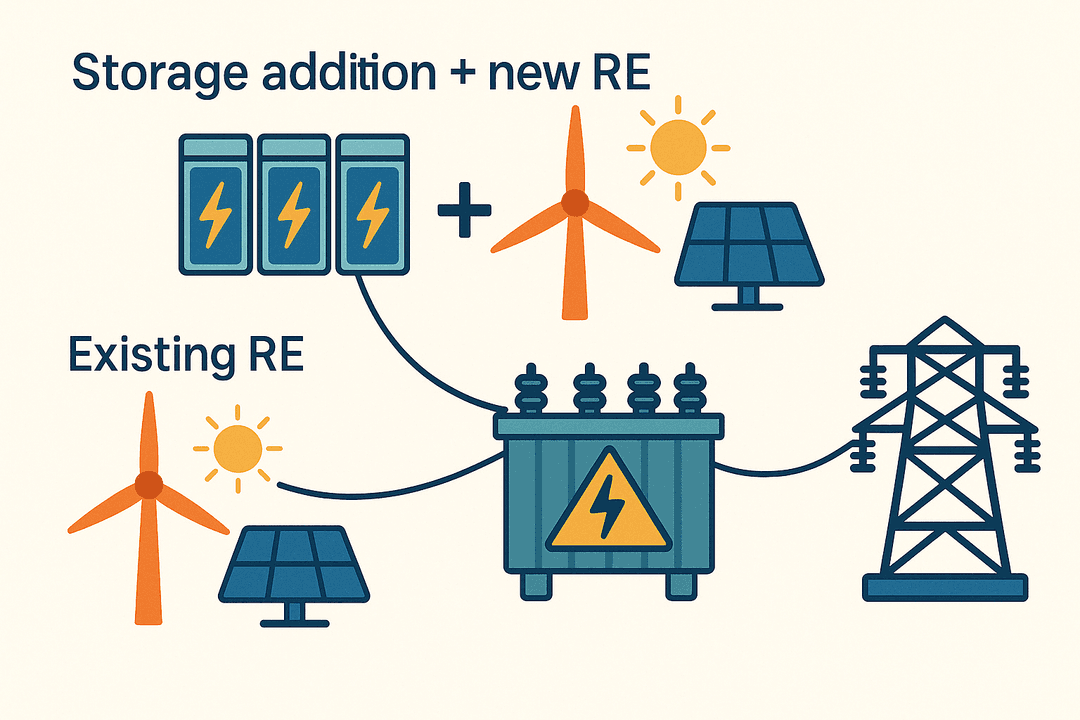SurplusInterconnectionin Indiana
Accelerating Clean Energy Deployment by Leveraging Existing Grid Infrastructure
Indiana's clean energy transition faces critical interconnection bottlenecks despite ambitious goals
The Problem
Interconnection Delays
Indiana has ~24 GW of active projects in interconnection queues (MISO and PJM), with average connection timelines exceeding 6 years— over 40 months to reach interconnection agreement, plus 2+ years for construction.
Tightening Supply Conditions
Indiana's electricity markets face substantial capacity challenges. MISO's summer 2025/26 capacity cleared at $666.50/MW-day (22× increase from 2022/23), while PJM's 2026/27 capacity reached the price cap at $329.17/MW-day (11.4× increase). MISO's capacity reserves have declined from 6.5 GW (2023) to 2.6 GW (2025), reflecting accelerating demand growth from data centers and electrification alongside thermal plant retirements.
New Gas Supply Challenges
New gas plants ordered today won't come online until 2030-2031 at earliest, creating a critical gap in meeting near-term capacity needs. Additionally, capital costs have surged: recent combined-cycle projects now cost $2,000/kW or more, up from $1,116-1,427/kW for 2026-2027 projects, making new gas generation increasingly expensive as a response to growing electricity demand.
Economic Opportunity Loss
Indiana faces growing economic development constraints as U.S. electricity demand is projected to increase 25% by 2030 and 78% by 2050, driven by data centers, AI infrastructure, and industrial electrification. With power availability now the primary site selection factor for data centers, Indiana's strategic position in both MISO and PJM territories creates unique opportunities. However, extended interconnection timelines and tightening capacity conditions limit the state's competitiveness for these high-value investments.
The Solution: Surplus Interconnection
Surplus Interconnection for Indiana
Surplus Interconnection Service allows new electricity supply resources to connect to the grid using existing infrastructure that serves already operating generators, without exceeding the total output capacity already allocated to the existing resource. FERC Order 845 (2018) cleared a regulatory pathway for generators to add new electricity resources to the grid by utilizing surplus capacity at existing interconnection points.
Key Results
Available Surplus Capacity
Indiana can add 39 GW of clean energy capacity through surplus interconnection, including ~21 GW at thermal plants (20 GW solar + 1 GW wind) and ~12 GW at renewable plants enabled by ~6 GW of 6-hour battery storage—all at existing sites without new transmission.
Cost Savings
Surplus interconnection can save $3.3 billion in interconnection costs by leveraging existing infrastructure, equivalent to $1,222 per Indiana household. This conservative estimate only accounts for interconnection savings—additional benefits from co-location and transmission utilization would increase total savings significantly.
Fast Deployment
Surplus interconnection projects can be completed in 12-18 months compared to 4-5 years for standard queue projects. MISO's process includes a 90-day interconnection study, followed by facility study if needed, then GIA tender—enabling rapid deployment when no network upgrades are triggered.
Thermal Interconnections
Indiana has 21.6 GW of thermal capacity, with 3.1 GW operating at less than 15% capacity factor (mostly gas peakers), leaving grid connections idle most of the time. By 2030, building new solar will be cheaper than operating 18.5 GW (86%) of existing thermal plants, even without IRA tax credits. By co-locating solar and wind at these sites, we can bypass lengthy interconnection queues and deploy approximately 21 GW of clean energy using existing infrastructure.

Key Results
Abundant Local Resources
~800 GW PotentialOver 818 GW of combined solar and wind potential exists within 6 miles of Indiana's thermal plants. This enormous renewable resource can enable clean energy deployment at existing interconnection points.
Urban Area Plants
1.5 GW Capacity11 thermal facilities (10% of total) with 1.5 GW capacity are located in urban areas. We removed these plants from the surplus interconnection analysis though they are great candidates for adding battery storage after the thermal plants get retired.
Economic Crossover
18.5 GW by 2030By 2030, building new solar will be cheaper than operating 18.5 GW of Indiana's existing thermal plants (86% of total thermal capacity), even without IRA tax credits. Currently, solar is already cost-competitive with 3.9 GW of thermal capacity.
Total RE Integration Potential
~21 GW by 2030Approximately 21 GW of total renewable energy (~20 GW solar + ~1 GW wind) can be economically integrated at Indiana thermal plants by 2030, using existing grid connections and avoiding lengthy queue delays.
Quick Wins Available
3.1 GW Ready3.1 GW of thermal capacity operates at less than 15% capacity factor, and 43.8% of Indiana's thermal capacity operates below 30% CF, creating immediate opportunities for surplus interconnection.
Renewable Interconnections
Indiana's 5.8 GW of existing renewable capacity operates at low capacity factors—solar at 13.2% and wind at 28.1%—meaning interconnection capacity sits idle 86.8% and 71.9% of the time respectively. Adding approximately 6 GW of 6-hour battery storage can enable an additional ~12 GW of renewable capacity and dramatically increase capacity factors to 80.1% for solar and 81.1% for wind, effectively turning variable renewables into firm power resources.

Key Results
Renewable Resource Potential
~207 GW TotalIndiana's existing renewable sites have approximately 207 GW of combined solar and wind resource potential within 6 miles of existing RE plants, representing enormous opportunity for expansion.
Battery Storage Integration
~6 GW of 6-Hour StorageAdding approximately 6 GW of 6-hour battery storage at Indiana's solar and wind sites would deliver firm, dispatchable capacity - helping meet peak demand and enhance grid reliability.
Additional RE Capacity
~12 GW EnabledIndiana's existing renewable interconnections can support an additional ~12 GW of renewable capacity when paired with ~6 GW of 6-hour battery storage, with no new grid connections required.
Maximized Utilization
80.1% Solar | 81.1% WindDeploying storage and additional renewables at existing interconnections dramatically improves capacity factors to 80.1% for solar and 81.1% for wind plants. This transforms intermittent renewables into firm resources comparable to gas CCGT plants.